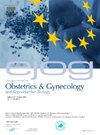Optimal surgical technique at cervical cerclage to prevent pregnancy loss, a systematic review
IF 1.9
4区 医学
Q2 OBSTETRICS & GYNECOLOGY
European journal of obstetrics, gynecology, and reproductive biology
Pub Date : 2025-09-30
DOI:10.1016/j.ejogrb.2025.114745
引用次数: 0
Abstract
Objective
Cervical cerclage has been used for decades for prevention of preterm birth; no consensus regarding optimal surgical technique exists. This review assesses if Shirodkar’s technique (bladder dissection) is superior to McDonald’s (without dissection) with respect to pregnancy loss and maternal-fetal outcomes. A secondary aim is to assess potential benefits of double cerclage.
Methods
Systematic review was conducted, PROSPERO protocol (CRD42023472563). MEDLINE, Embase, CINAHL and Cochrane Library were searched. 1647 abstracts were screened, 22 studies met inclusion criteria. Bias was assessed using ROBINS-I and ROB2 and meta-analysis conducted using RevMan.
Results
Odds of pregnancy loss and birth <37 weeks did not differ between dissection and no dissection groups (OR 0.95 [95 %CI 0.60–1.48], I238%), (OR 0.86, [95 %CI 0.63–1.19], I223%). Dissection prolonged pregnancy by 2 weeks (MD 2.29 [95 %CI 1.49–3.10], I244%) and reduced birth <32 weeks, (OR 0.43 [95 %CI 0.19–0.61], I20%). Double cerclage reduced pregnancy loss, (OR 0.52 [95 %CI 0.28–0.98], I229%), and birth <28, <32, <34 weeks, however not at <37 weeks, (OR 0.96, [95 %CI 0.64–1.45] I235%).
Conclusions
No difference in odds of pregnancy loss was evident between surgical techniques, however dissection was associated with prolongation of pregnancy by 2 weeks and reduced odds of birth <32 weeks. Double cerclage may provide additional benefits in prevention of preterm birth. Overall quality of evidence is low. Choice of technique should be informed by obstetric history, clinical examination, and clinician preference.
最佳手术技术在宫颈环扎术,以防止妊娠丢失,系统回顾
目的宫颈环扎术用于预防早产已有几十年的历史;关于最佳手术技术尚无共识。本综述评估了Shirodkar技术(膀胱剥离)在妊娠损失和母胎结局方面是否优于McDonald技术(不剥离)。第二个目的是评估双重环扎术的潜在益处。方法采用PROSPERO方案(CRD42023472563)进行系统评价。检索MEDLINE、Embase、CINAHL和Cochrane Library。共筛选1647篇摘要,22篇研究符合纳入标准。使用ROBINS-I和ROB2评估偏倚,使用RevMan进行meta分析。结果分离组和未分离组的37周流产率和出生率差异无统计学意义(OR = 0.95 [95% CI 0.60-1.48], I238%), OR = 0.86, [95% CI 0.63-1.19], I223%)。剥离使妊娠延长2周(MD为2.29 [95% CI 1.49-3.10], I244%),使分娩缩短32周(OR为0.43 [95% CI 0.19-0.61], I20%)。双环扎术减少了妊娠损失(OR 0.52 [95% CI 0.28-0.98], I229%),减少了28周、32周和34周的出生(OR 0.96, [95% CI 0.64-1.45] I235%)。结论不同手术方式的流产率无明显差异,但剥离术与妊娠延长2周和32周分娩率降低相关。双环扎术可能在预防早产方面提供额外的好处。证据的整体质量较低。技术的选择应根据产科史、临床检查和临床医生的偏好。
本文章由计算机程序翻译,如有差异,请以英文原文为准。
求助全文
约1分钟内获得全文
求助全文
来源期刊
CiteScore
4.60
自引率
3.80%
发文量
898
审稿时长
8.3 weeks
期刊介绍:
The European Journal of Obstetrics & Gynecology and Reproductive Biology is the leading general clinical journal covering the continent. It publishes peer reviewed original research articles, as well as a wide range of news, book reviews, biographical, historical and educational articles and a lively correspondence section. Fields covered include obstetrics, prenatal diagnosis, maternal-fetal medicine, perinatology, general gynecology, gynecologic oncology, uro-gynecology, reproductive medicine, infertility, reproductive endocrinology, sexual medicine and reproductive ethics. The European Journal of Obstetrics & Gynecology and Reproductive Biology provides a forum for scientific and clinical professional communication in obstetrics and gynecology throughout Europe and the world.

 求助内容:
求助内容: 应助结果提醒方式:
应助结果提醒方式:


